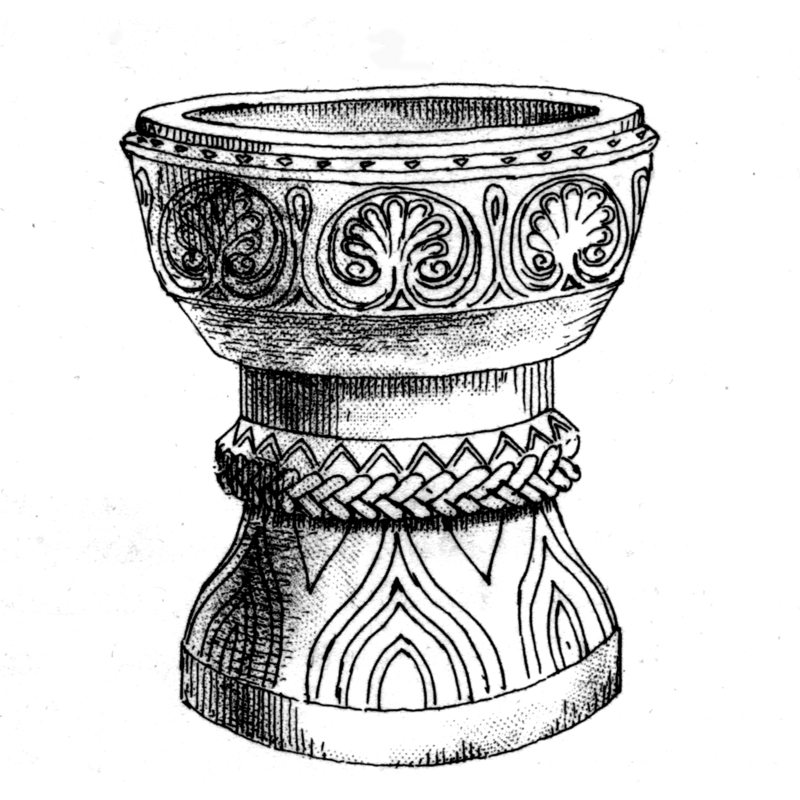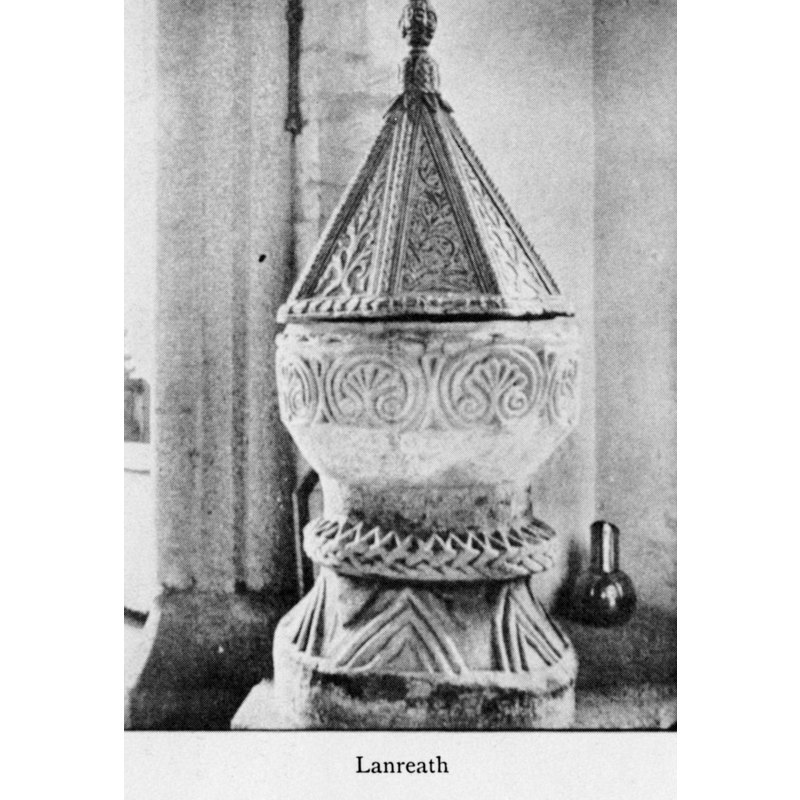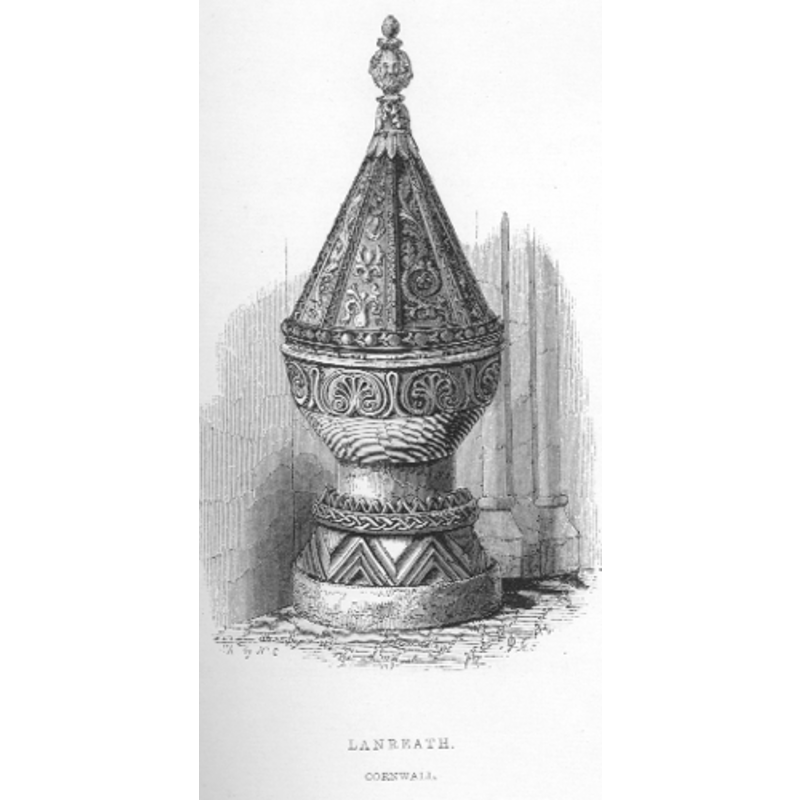Lanreath / Lannreydhow

Image copyright © [in the public domain]
PD
Results: 7 records
B01: design element - motifs - Greek palmette motif (anthemion)
CR01: design element - motifs - braid
LB01: design element - motifs - chevron
LID01: design element - motifs - foliage
view of font
view of font and cover
INFORMATION
FontID: 01451LAN
Object Type: Baptismal Font1
Church/Chapel: Parish Church of St. Marnarck and St. Dunstan
Church Patron Saints: St. Dunstan & St. Marnarck [aka Marnach, Manarck] Manacus? Mancus?
Church Location: Lanreath, Truro PL13 2NU, United Kingdom
Country Name: England
Location: Cornwall, South West
Directions to Site: Located off the B3359, 9-10 km WNW of West Looe, 15-20 km SE of Bodmin
Ecclesiastic Region: Diocese of Truro
Font Location in Church: Inside the church, at the W end of the aisle, near the south door
Century and Period: 12th - 13th century, Late Norman / Transitional?
Cognate Fonts: Fowey, etc.
Credit and Acknowledgements: We are grateful to the Thomas Fisher Rare Books Library for access to the copy of Lysons’ Magna Britannia, and to Jim Ingram, of the Preservation Services, Robarts Library, for the digital imaging of Lysons’ illustrations.
Font Notes:
Click to view
Noted in Lysons (1806-1833) as one of a group of remarkable fonts in this county, "all nearly alike, being square at the top, with human heads at the corners, and circles inclosing [sic] stars on the sides, supported by serpents, &c." Noted and illustrated in Upcott (1818) [with reference to Lyson]. Described and illustrated in Paley (1844), who comments on the upright position of the zig-zag motif on the shaft as "giving it greatly the appearance of the tooth ornament"; he refers to the richly carved pyramidal cover as "a good specimen of the taste of the seventeenth century, not as a model to follow". Lewis' Dictionary of 1848 reports "a curious Norman font" in this church [NB: the adjective 'curious' in this context is a synonym of 'interesting']. The Antiquary (issue No. 35, vol. 6, November 1882: 220) reports a visit by the Royal Institution of Cornwall to Lanreath church, where they report "a very interesting carved Norman font". Described and illustrated in Bond (1908) as a chalice-shaped font of the Norman period; the round bowl has a wide band with symmetrical Greek palmette motif (anthemion) under the rim; the stem of the base has prominent braiding instead of the more usual cable/rope motif; there are chevron motifs on the lower base. Described in Cox & Harvey (1907) as a noteworthy example of the Norman period. Described in Cox (1912): "Circular font, 29 in. in diameter, is a fine and unusual example of early Norm[an] ; both bowl
and base richly carved ; small cross cut on the rim is sometimes erroneously described as 'a consecration cross.' There is a good octagonal font-cover of
early I3th cent. date." Noted in Pevsner (1970): "Font. Norman, of Catacleuse stone, Fowey type, that is, cup-shape. Uncommonly rich, with zigzag, plait, palmettes, etc.. Cover. Handsome shape and decoration; Jacobean."
COORDINATES
Church Latitude & Longitude Decimal: 50.38348, -4.5596
Church Latitude & Longitude DMS: 50° 23′ 0.53″ N, 4° 33′ 34.56″ W
UTM: 30U 389122 5582432
MEDIUM AND MEASUREMENTS
Material: stone, Cornish Catacleuse stone
Font Shape: chalice-shaped
Basin Interior Shape: round
Basin Exterior Shape: round
Diameter (includes rim): 68.75 cm* / 72.5 cm**
Basin Depth: 25 cm
Font Height (less Plinth): 99 cm*
Notes on Measurements: * [in inches in Paley (1844)] -- ** [in inches in Cox (1912)]
LID INFORMATION
Date: 17th century / Jacobean
Material: wood
Apparatus: no
Notes: "Good specimen of the taste of the seventeenth century, not a model to follow" (Paley, 1844, unpaged) Vegetable/floral motif contained in each of the eight isosceles triangles which form the sides of the lid (based on ill. in Bond, p. 145). Cox (1812) noted a 13th-century font cover (?)
REFERENCES
"On the ancient stone fonts of Cornwall: a communication", 83 (April 1851) / New Series no. 47, Ecclesiologist, 1851, pp. 96-102; p. 99
Bond, Francis, Fonts and Font Covers, London: Waterstone, 1985 c1908
Cox, John Charles, Cornwall, London: George Allen & Company, 1912
Cox, John Charles, English Church Furniture, New York: E.P. Dutton & Co., 1907
Friar, Stephen, The Sutton Companion to Churches, Thrupp, Stroud (Gloucs.): Sutton Publishing, 2003
Lewis, Samuel, A Topographical Dictionary of England, Comprising the Several Counties, Cities, Boroughs, Corporate and Market Towns, Parishes, Chapelries, and Townships, and the Islands of Guernsy, Jersey, and Man, with Historical and Statistical Descriptions [...], London: S. Lewis, 1831
Lysons, Daniel, Magna Britannia, being a concise topographical account of the several counties of Great Britain, London: Printed for T. Cadell and W. Davies, 1806-1822
Paley, Frederick Apthorp, Illustrations of Baptismal Fonts, London, UK: John van Voorst, 1844
Pevsner, Nikolaus, Cornwall, Harmondsworth: Penguin Books, 1970
Stocker, D.A., "Fons et origo: The Symbolic Death and Resurrection of English Font Stones", I (1997b), Church Archaeology, 1997, pp. 17-25; p. 121
Upcott, William, A bibliographical account of the principal works relating to English topography, London: Printed by Richard and Arthur Taylor, 1818

